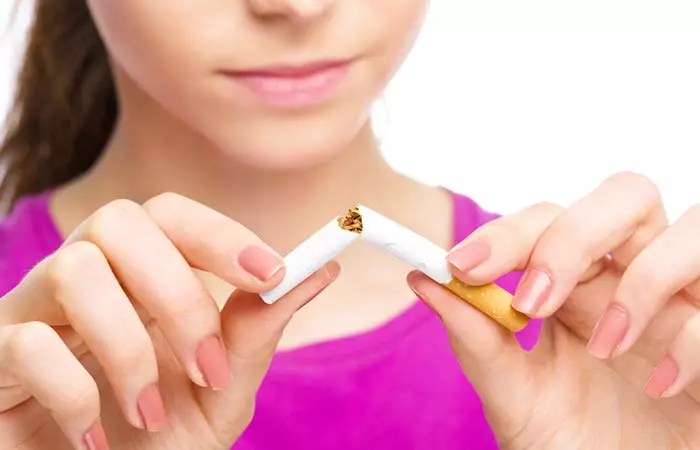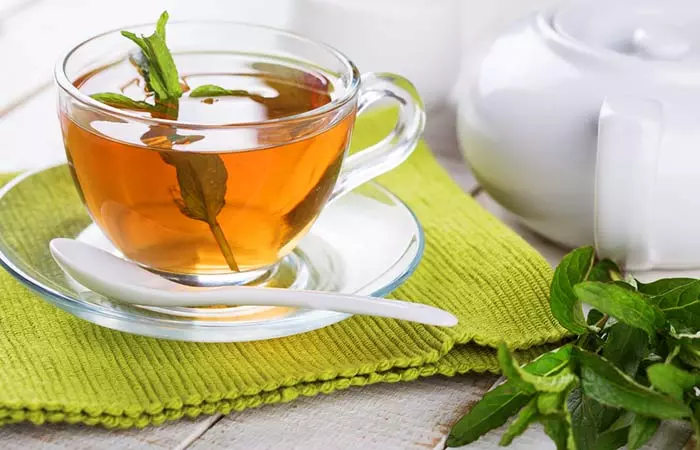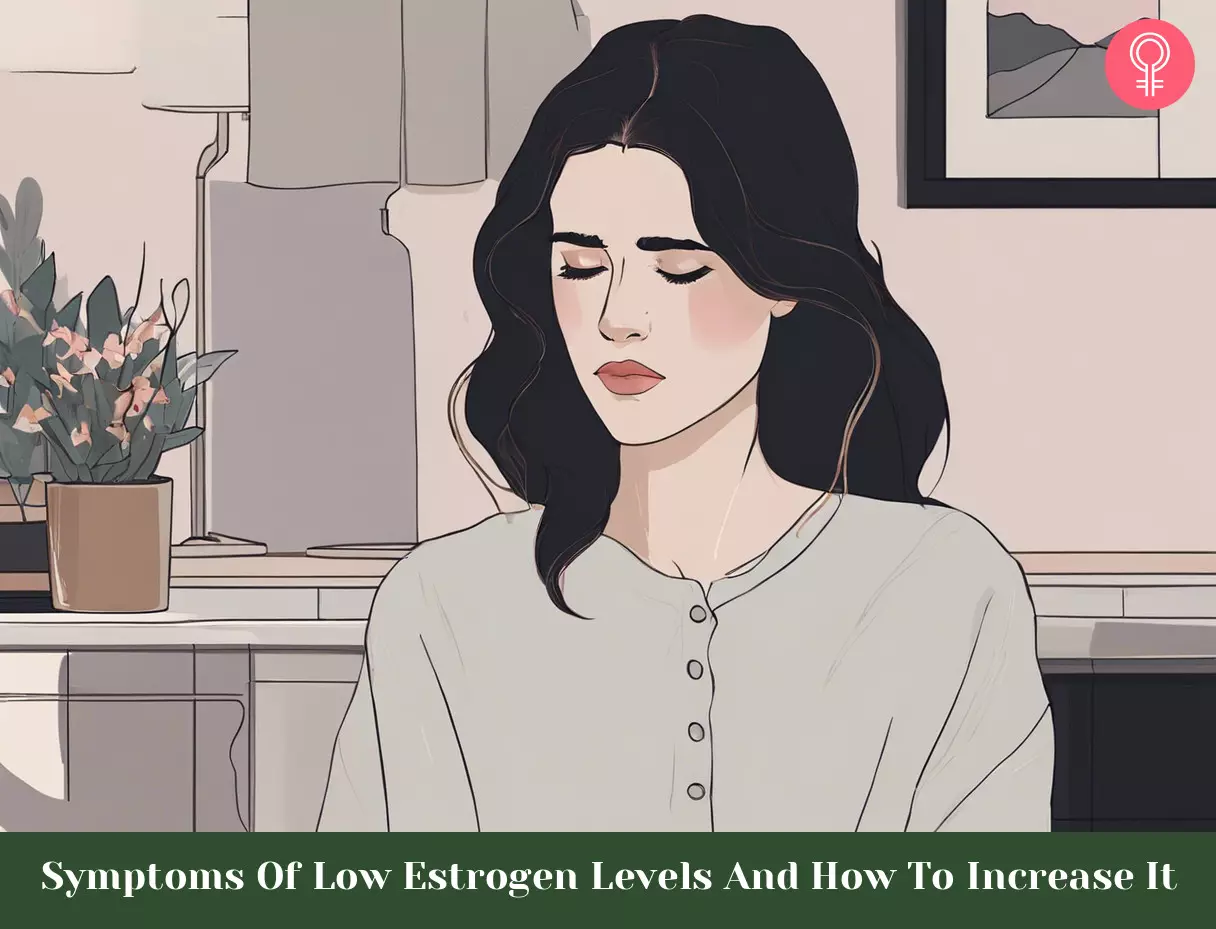Estrogen And Its Types
Estrogen is a steroid hormone that plays a significant role in the growth and development of the human reproductive system. It also influences the skeletal and cardiovascular systems (1). This hormone is mainly of 3 types: estradiol, estrone, and estriol (2). Here is what you need to know about them:
Estradiol: It is the primary and most potent form of estrogen that a female produces during her reproductive years. Estrone: It is the weakest type of estrogen your body makes after your period stops during menopause. Estriol: It is a weak form of estrogen that your body produces during pregnancy to prepare the uterus for childbirth (3).
Estrogen plays a major role in a woman’s entire lifespan. But what if its level falls? Learn more about low estrogen in the next section.
What Is Low Estrogen?
The estrogen hormone is produced in the ovaries, and anything that affects the ovaries causes a deficiency in estrogen levels. Several factors cause low estrogen levels. They include:
Excessive exercise Chronic kidney disease Turner syndrome (a disorder where a female is born only with one X chromosome) A low-functioning pituitary gland Anorexiai An eating disorder characterized by a fear of weight gain and a distorted body image; often to try and cope with emotional issues. or other eating disorders Premature ovarian failure or any other autoimmune disorder Tubal ligation can inadvertently cut down blood supply to the ovaries and lower estrogen levels Magnesium deficiency The birth control pill suppresses both estrogen and progesterone Hypothyroidism Adrenal fatigue Yeast overgrowth with yeast toxins blocking hormone receptor sites
A study conducted on 4,402 Croatians found the prevalence of hypothyroidism was 10.5%. It was further noted that the prevalence rates of clinical hypothyroidism and subclinical hypothyroidism were 3% and 7.4% respectively. Furthermore, it was estimated that women had 2.37 times higher odds of subclinical hypothyroidism than men. Estrogen levels peak in the late 20s and during perimenopause, greatly fluctuate around a normal range until menopause. Most women in the US go through menopause between the ages of 40 and 58, with 51 being the average age. This graph shows estrogen levels in the reproductive interval and changes in hormone levels during perimenopausal and postmenopausal intervals.
Drop In Estrogen Levels With Age In Women
What Are The Symptoms Of Low Estrogen Levels?
Girls who haven’t yet reached puberty or women approaching menopause are at a higher risk of low estrogen. However, women of all ages can experience this condition. Some of the common symptoms of this problem include:
Hot flashes Night sweats Mood swings Depression Headaches (or even migraines) Fatigue Issues with concentration and focus Absent or irregular periods Urinary tract infections Painful sex (due to the vaginal dryness) Weak bones or frequent fractures (as estrogen works in conjunction with calcium, magnesium, and vitamin D, and its deficiency can mean a decrease in bone density) Joint pain Bone loss (old bone tissue is reabsorbed rather than new ones being created) Dry skin
How To Increase Estrogen Levels
1. Get Your Levels Checked
Visit your doc. That’s the first thing you need to do. Even before you start off with an estrogen program (or any other way of increasing the levels in your body), take your doctor’s advice. There are a variety of tests that can determine your hormone levels. Your blood might be tested for FSHi A hormone released by the pituitary gland to regulate egg and sperm production, menstrual cycle, and sexual development. (Follicle-Stimulating Hormone). If that is all that is wrong, you might want to try estrogen therapy after consulting your doctor. The therapies can include pills, topical gels, or skin patches and they may be synthetic hormones or bioidentical However, there are many options to investigate before resorting to hormone replacement. Let’s see how you can help your body make its own hormones.
2. Quit Smoking
Kick the butt. Smoking can have detrimental effects on the endocrine system, and this can limit your body’s ability to produce estrogen (4).
3. Change Your Diet
Your endocrine system needs a healthy body to produce adequate levels of estrogen. Eat healthily and make certain that your food is non-GMO. Try consuming foods that contain phytoestrogens. We know that soy products like tofu, soy nuts, and edamame produce phytoestrogens, which mimic the effects of estrogen. But soy is very hard to digest, and many people are allergic to it, so tread lightly. Other foods that contain phytoestrogens include peas, lima beans, cranberries, apricots, prunes, broccoli, cauliflower, flax seeds, raw pumpkin seeds, red clover sprouts, mung bean sprouts, and whole grains. Also, cut down on your sugar intake as it can lead to hormonal imbalances in the body (5). Sugar also contributes to yeast overgrowth, and yeast toxins can block hormone receptor sites. Adding magnesium-rich foods to your diet or magnesium supplements can help promote estrogen production and prevent symptoms of low estrogen. You can also consume low glycemic indexi A measure of how quickly carbohydrates in food affect blood sugar levels, used by people to select foods with a low sugar impact. fruits, complex carbohydrates, good quality proteins and fats, and natural herbs to reduce inflammation in the body and improve cell receptivity for various hormones.
4. Try Gaining Weight
In case you are underweight, that is. Being underweight can hinder your body’s ability to produce estrogen. Returning to a healthy weight can improve your estrogen levels. Young female athletes who are under 100 lbs can lose their periods to low hormone levels. You need body fat to produce hormones.
5. Go For Chasteberry Supplements
Chasteberry is a herb that has shown to influence estrogen levels (6). But consult your doctor before consuming it as research in this aspect is limited as of now. Also, avoid chasteberry if you are taking birth control pills or using medications to treat Parkinson’s diseasei An incurable neurological disorder caused by dopamine loss leading to trembling, slow movement, and impaired balance and coordination. .
6. Consume Herbal Teas
Several herbal teas are found to enhance estrogen levels. These include red clover, alfalfa, hops, licorice, thyme, verbena, and saw palmetto. You can simply steep the herbs in hot water for about 5 minutes and then drink the tea. But as with chasteberry, don’t go overboard. The best way to tell if you are stimulating too much estrogen is sore breasts. Black and green teas contain phytoestrogens and can improve estrogen levels in your body.
7. Try Coffee
But not more than 400 mg of caffeine a day. Studies have shown that women who take more than 200 mg of caffeine a day have higher levels of estrogen than women who don’t. But ensure you use organic coffee. Most coffee is the heavily sprayed crop, which is why drinking organic coffee can keep you away from pesticides and other harmful fertilizers. And remember that caffeine is a strong stimulant, so don’t take it if you are already speedy.
8. Embrace Exercise
Though there is research that heavy exercise can lead to a drop in estrogen levels, moderate exercise is just plain healthy and can cut the risk of breast cancer and increase longevity. These are some ways you can increase estrogen levels in your body. But ensure the levels are not too high as that might lead to another set of issues.
9. Increase Your Fluid Intake
Increase your intake of fluids like water, juice of green leafy vegetables like celery, spinach, kale, and lettuce, green tea, and coconut water to flush out toxins from the body. It relieves oxidative stress and enhances hormone production in the body. Vita, a YouTuber, discusses the often-overlooked issue of low estrogen levels in women, sharing her experience with both estrogen dominance and low estrogen. She says, “I managed to raise estrogen levels successfully just by stopping to exercise so much. I’m really scaling down on my exercise routine and giving myself enough rest, relaxing as much as I could, stopping all kinds of fasting and just really eating a lot, all kinds of foods, and not limiting myself in any way (i).”
What Happens With Excess Estrogen Levels?
Also called estrogen dominance, this condition is more common than low estrogen and is marked by the following symptoms:
Bloating Decreased sex drive Mood swings Headaches Insomnia Irregular menstrual periods Cold hands or feet Weight gain Hair loss Anxiety/panic attacks Fatigue Memory problems Breast tenderness/breasts containing fibrocystic lumpsi Non-cancerous growths usually found in breasts; can be tender or painful and vary in size but are generally not harmful.
Can estrogen cause belly fat? Check out the below infographic to learn which exercises you should try if you have low estrogen levels. Note: Please try these exercises after consulting your doctor. Certain exercises might be too strenuous for some.Illustration: StyleCraze Design Team The best way to balance the estrogen levels is to get them checked at the earliest, quit smoking, and adopt a diet free from GMO foods. Also, hydrate yourself properly, exercise, and try taking herbs like chasteberry and red clover tea or alfalfa tea to treat this condition. Low estrogen levels could lead to build up of abdominal fat (7). When should I take estrogen pills? These are usually taken once a day without food. However, you should follow the dose as prescribed by your doctor. What vitamins can increase estrogen? B vitamins, especially vitamin B2 and B6 are associated with healthy levels of estrogen production.
Illustration: Symptoms Of Low Estrogen Levels And How To Increase It













